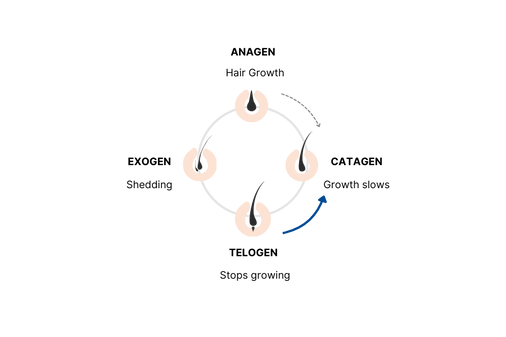Hair loss is an issue that affects millions of people, but the solutions go far beyond surface-level treatments. The key to managing hair loss lies deep within your hair follicles—at the cellular level.
In this blog, we’ll help you understand how the hair growth cycle works, why hair loss happens, and the advanced science behind today’s most effective treatments so you can make informed choices about your hair’s health.
Hair Growth 101
Let’s first understand our natural hair growth cycle. This process involves three key stages:

- Anagen (Growth Phase): This is when your hair actively grows. The anagen phase typically lasts between 2 to 7 years, and the length of this phase determines how long your hair can grow.
- Catagen (Transition Phase): This is a short phase, lasting around 2 weeks, where the hair follicle begins to shrink, and growth slows down.
- Telogen (Resting Phase): During the telogen phase, hair growth stops, and the hair eventually falls out, making way for new strands to grow.
Hair loss occurs when the balance between these phases is disrupted. That’s why it becomes crucial to optimize the hair growth cycle for effective hair loss prevention: keeping as many hair follicles in the anagen (growth) phase for as long as possible and minimizing the time they spend in the telogen (resting) phase. Factors like hormonal imbalances, stress, genetics, and aging can cause hair follicles to enter the resting phase prematurely, leading to thinning and excessive shedding.
Traditional Hair Loss Treatments and Their Limitations
For decades, people have relied on treatments like Minoxidil or hair transplants to combat hair loss, but these options aren’t without their drawbacks.
- Chemical Ingredients: Minoxidil stimulates the hair follicles to grow but can come with side effects like scalp irritation, itching, and unwanted hair growth in areas like the face or neck, especially for women. Results are often inconsistent and stop if the treatment is discontinued.
- PRP (Platelet-Rich Plasma): This therapy involves drawing a patient’s blood, processing it to concentrate the platelets, and injecting it into the scalp. While effective for some, PRP is invasive and time-consuming, requiring multiple sessions to see significant results.
- Hair Transplant Operation: Hair transplants can be a more permanent solution but are highly invasive, expensive, and not always an option for those with diffuse hair thinning. It also requires significant recovery time, and results can take months to fully appear.
- Exosomes: Exosomes work on a biological level, meaning they can address the root cause of hair loss, not just the symptoms. That’s because they have the natural ability to communicate with our hair follicle cells—shifting them out of the resting (telogen) phase and back into the growth (anagen) phase, optimizing the hair growth cycle for healthier, fuller hair. The key benefit of this approach is that it is free from invasive procedures or chemical stimulants.
Clinical Boosts vs. Daily Maintenance: A Dual Approach to Hair Health
While clinical treatments provide a much-needed boost to kickstart hair growth, daily maintenance is just as important for maintaining long-term results. Think of it like visiting the dentist: you go for professional cleanings, but you still need to brush your teeth every day to keep them healthy.
Professional hair loss targeting treatments like WBI’s RetroEV® EXO HAIR and HAIR GROWTH formulas are designed to deliver concentrated doses of exosomes and growth factors. These in-clinic treatments provide a powerful boost to hair regeneration by stimulating hair follicles in a clinical setting, targeting thinning areas with precision.
WBI’s MORIMANA is specially designed to complement these clinical treatments by delivering a consistent, daily dose of exosomes, bioactive complexes, and botanical ingredients that support ongoing scalp and hair health.
Think of it like getting your monthly facial from a dermatologist, but you still need to apply daily anti-aging skincare or SPF for lasting, visible results.
Conclusion
Hair loss treatments have come a long way, moving beyond traditional, surface-level solutions to more advanced therapies that target hair follicles where it matters most—at the cellular level. Exosomes, with their ability to communicate directly with hair follicle cells, offer a cutting-edge solution for promoting hair growth and maintaining a healthy scalp.
However, just like any effective regimen, combining clinical treatments with daily care is key to long-term success. Exosome-based therapies, like RetroEV’s EXO HAIR and MORIMANA’s daily haircare system, provide a holistic system to keep your hair looking fuller, healthier, and stronger.
